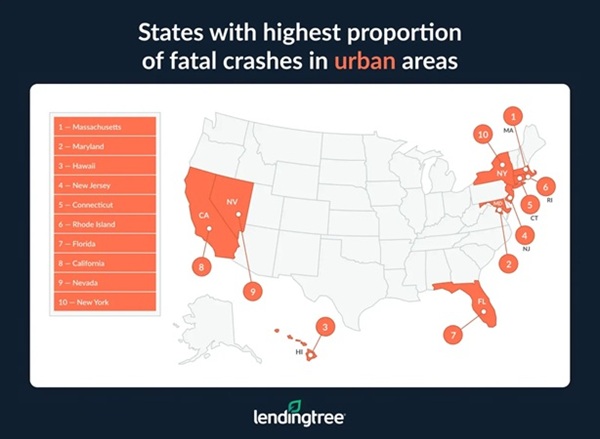BALTIMORE, MD—Maryland’s bustling urban streets are becoming increasingly dangerous, turning everyday commutes into growing safety concerns for drivers.
According to the latest LendingTree study, 93% of fatal crashes were in urban areas of Maryland while 6% were in rural areas, the 2nd largest difference in the country.
The results showed that:
- Maryland saw a 42% increase in urban fatal crashes from 2019 – 2023.
- Maryland experienced a 71% decrease in rural fatal crashes from 2019 – 2023, the largest decrease among all U.S. states.
- Urban areas accounted for nearly 3 in 5 fatal crashes across the U.S.
- Fatal crashes in urban areas increased 19% from 18,753 in 2019 to 22,400 in 2023. Over the same period, fatal crashes in rural areas increased 2%.
Cities can be hot spots for dangerous driving. In fact, 59.5% of fatal crashes in 2023 were in urban areas, versus 39.7% in rural areas. (Despite this, rural roads account for 70.2% of public road miles, versus 29.8% for urban roads, according to Federal Highway Administration, or FHWA, data.)
LendingTree auto insurance expert and licensed insurance agent Rob Bhatt says that’s a commonly understood disparity. “Crash risks are inherently higher in cities and suburbs than in the country,” he says. “Simply, drivers have more vehicles and people to crash into.”
Alcohol was a significant contributing factor for fatal crashes in both urban and rural areas in 2023, at 35.2% and 35.0%, respectively. Speeding contributed to 28.4% of fatal crashes in urban areas and 27.6% in rural areas. And motorcycles were more likely to be involved in fatal crashes in urban areas than in rural areas, at 18.1% versus 14.4%.
By state, Massachusetts saw the biggest disparity in fatal crashes in urban areas.
A staggering 95.4% of fatal crashes in Massachusetts were in urban areas, versus just 4.6% in rural areas. That’s a 90.8 percentage point difference.
Maryland followed, with 93.2% of crashes in urban areas and 5.5% in rural areas — an 87.7 percentage point difference. Hawaii rounded out the top three, at 90.9% in urban areas and 8.0% in rural areas — an 82.9 difference.
Bhatt says that may impact insurance rates in these states.
“The crash rates in your area are among several factors insurance companies look at to determine your rate,” he says. “Insurance companies tend to look at crash rates per capita and by vehicle miles driven. We tend to see lower auto insurance rates in rural areas because they usually have lower crash rates. That said, there are outliers. If you live in a rural area with a high crash rate, you may get a higher insurance rate than drivers in a nearby urban area with a lower crash rate.”
The top ten can be viewed below and the full study is available online here.



